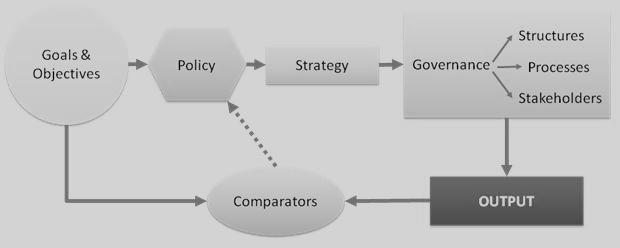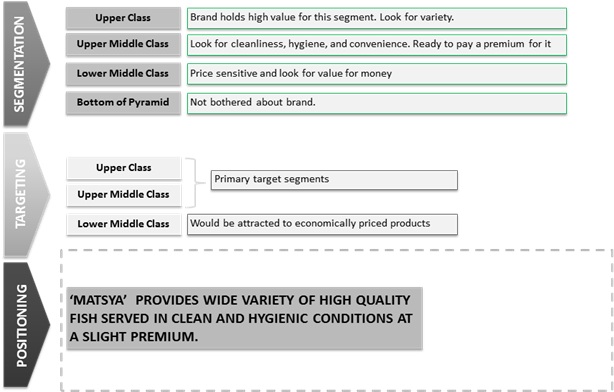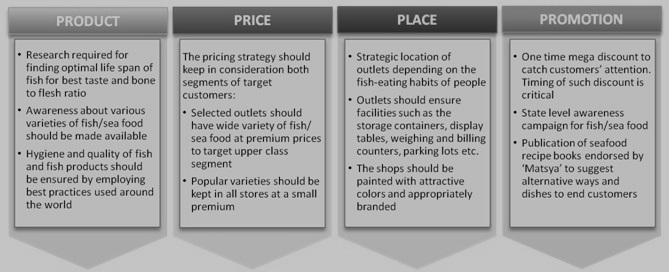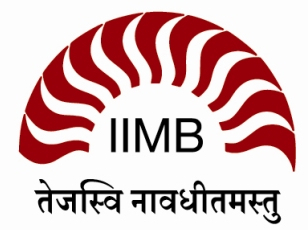Quality and Hygienic Fish Marketing in Karnataka
Faculty Contributor : S. Nayana Tara, Professor
Student Contributors : Ragul K, Sadanand Subray Kamat, Rakesh Kumar, Dudhe Pramod Pandharinath and Bharadwaj Srivatsan S
Commodity markets have always been a difficult ground for implementing any kind of marketing model. The fisheries market in Karnataka has always been a simple demand-supply driven market, and calls for some discipline in the way that the market operates. This project attempts to design an integrated marketing strategy and an effective branding strategy to increase sales and improve profitability of this industry. The analysis of the supply/demand side gave ample scope for introducing a new brand. The name Matsya (means ‘fish’ in Sanskrit and Kannada) was coined and promotional strategies involving advertisements, food festivals and aesthetic outlets were designed.
Karnataka, endowed with a long coastline, many rivers and other water bodies, offers plenty of scope for the fishing industry. It has about 5 lakh hectares of inland water resources (about 9.3% of inland water resources of India) and 300 kms of coastline with 27,000 sq. km of continental shelf, which offers great opportunities for the fishing industry. The fisheries sector plays a vital role in the socio-economic development of the state, with contributions to the food basket, nutritional security, foreign exchange earnings, employment generation and income. The average fish production of the state in the last five years was about 2.73 lakh tons, which contributed about 4.8% to India’s total fish production. The marine sector contributes 64% of the production with the inland sector contributing the remaining 36% 1 . The sale of fresh water fish caters primarily to domestic demand whereas marine fish caters to both domestic as well as export demand.
Department of Fisheries, Karnataka
The Karnataka Department of Fisheries was set up in 1957 with the stated goal of the overall development of fisheries and of fishermen in the state by implementing several schemes both in the marine and inland sectors. The objectives of the department are to augment fish production, encourage deep-sea fishing, and create employment in the rural areas and to improve the socio-economic condition of fishermen 2 . The department achieves these by offering subsidies for reconstruction of fish markets, purchase of inputs for marketing fish and various welfare schemes. The fishing industry in Karnataka is very fragmented on production and supply side though there is large demand for the fish in the state. The main driver for our initial studies is to understand how fish sells in Karnataka and suggest an effective and sustainable marketing model to improve the sale of fish in Karnataka.
Market Study
How can an effective and sustainable marketing model that promotes quality and hygienic fish improve sale of fish and fish products in Karnataka? The goal of the project is to design an integrated marketing strategy and an effective branding strategy to increase the sale and improve the profitability of the fisheries business. The project aims to understand the supply chain in the fisheries product markets in Karnataka, and find out ways to make available the highest quality produce in the market.
Objectives
We defined two levels of objectives, one set as prerequisites before venturing into the development of a fully-fledged marketing strategy, and a second set for the development of the strategy itself. Major objectives were to understand the existing demand supply situation in Bangalore, understand customer expectations and based on these understandings, envision and devise a comprehensive strategy for the marketing and branding of the fish produce including development of a brand name and logo and propose a sustainable marketing model.
Methodology
We collected the sample data by conducting personal interviews with various people involved in the supply chain of fish at major wholesale fish markets and malls in Bangalore. The persons interviewed included wholesalers who sell a few tonnes of fish every day, shop personnel who sell fish in malls, retailers who sell fish through small shops, fish procurement personnel in the hub and spoke procurement model of a chain of malls and government officials in the fisheries department. A consumer survey captured data on the consumption patterns and customer perceptions about fish.
Data Analysis
Bangalore procures and consumes about 40-50 tonnes of fish every day. The market for fish in Bangalore is composed of wholesalers, retail fish outlets and malls. About 80% of the fish consumed in Karnataka is marine fish. Marine fish supply comes from all places along the coastline like West Bengal, Orissa, Andhra Pradesh and Tamil Nadu to Karnataka. Freshwater fish supply comes from Karnataka and the nearby states of Andhra Pradesh, Tamil Nadu and Kerala. The dried fish market is extremely small compared to the fresh fish market, averaging around 500kg of fish sales per week. The demand for dried fish rises after December when supply of fresh fish reduces and their prices rise.
Supply Chain in Malls
Recently many malls (Reliance, Spar, Spencer’s and Total to name a few) have started selling fresh and packaged fish in their food stores. While Spar procures fish from wholesalers in Russell Market, Reliance has adopted an independent hub and spoke model. They procure the fish directly from Andhra Pradesh to a centralized location (hub) near the outskirts of Bangalore. The fish outlet in each of the 24 Reliance malls in the city reports to the hub about their next day’s requirement. By adopting this model, Reliance has gained control over its supply of fish. Each of the Reliance or Spar outlets in Bangalore sells about 50 to 150 kg of fish every day
Issues in the Fish Markets
A vast majority of fish wholesalers and retailers are mostly unaware about the existence of the Department of Fisheries. Absence of a fish sellers’ association leads to price instability in the market and they have little influence over the suppliers. The retailers also end up paying high rents for their shops for the lack of a government market area. A lack of demand for fresh water fish is forcing the fresh water fish wholesalers to bundle and sell fresh water fish with marine fish to malls. In addition, hotels, which are major customers, pay only at month ends, leading to cash flow problems for retailers. Transport strikes also cause delay and spoilage of fish occasionally.
Customer Expectations
The data collected from surveys suggested that over 68% of the people purchase fish from the fish market. The combined share of local street vendors and retail outlets comes to a meagre 32%. Customers who did try frozen and canned fish said that their motivation for doing so was primarily cleanliness and higher quality followed by brand name and packaging. Customers ranked cleanliness as the most important factor while purchasing fish, followed closely by the type of fish. Also over 68% of customers were willing to try out a new brand of fish if it met their quality requirements and 78% of these were even willing to pay a premium for it.
Recommendations
We use the Governance Framework illustrated in exhibit 1 below to solve the issues of the fish sellers as well as help realize customer expectations.
 Exhibit 1 The Governance Framework
Exhibit 1 The Governance Framework
Policies
- Create an infrastructure fund for the development of the infrastructure required for fish markets in the state.
- Setting up a common market for all animal and fish produce in Bangalore.
- Framing of a policy to create a revolving credit facility to the wholesale marketers with each seller having a credit limit up to which he can get cash on credit.
- An active awareness building body has to be set up to make the fish sellers aware of the Directorate of Fisheries’ schemes and avail them.
Strategies
One of the most important steps in the branding strategy for this product is to create a brand identity. We designed a logo (Exhibit 2), which will help to communicate to the consumers that a product with great quality and hygiene is available for ready use as opposed to products sold from unhygienic local retail outlets.
 Exhibit 2 Proposed Logos for Matsya
Exhibit 2 Proposed Logos for Matsya
Developing the Matsya Chilled Fish Brand
Matsya will be the first ever brand of chilled fish sold in India. The advantage of chilled fish over frozen fish is that it is very soft and retains its tenderness. We strongly believe this will also be the case with chilled fish if implemented successfully.
To develop the marketing strategy, we apply the approaches of Segmentation, Targeting and Positioning (STP) and 4P to Matsya (Exhibit 3 and 4).
 Exhibit 3 The STP Framework for Matsya
Exhibit 3 The STP Framework for Matsya
 Exhibit 4 The 4P Model for Matsya
Exhibit 4 The 4P Model for Matsya
Communication Mix
The promotion of the brand involves communicating the right information to the right people at the right time. Some of the recommendations for the communication mix (Exhibit 5) include:
- Launch Television and print ads to communicate the unique qualities of the brand Matsya.
- Distribute pamphlets and brochures containing information about the fish and their prices, sold through the Matsya outlets to as many people as possible.
- Launch a website for the Matsya brand and update it with information about the fishes, daily prices and location of the nearest outlets.
 Exhibit 5 Communication Mix
Exhibit 5 Communication Mix
Other Marketing Strategies
Some of the other marketing strategies that can be utilised to market the Matsya brand are:
- Organize food festivals across the state to increase the awareness among fish consumers about different varieties of fish available and their nutritional values. Give out a few samples so that customers experience the taste of different fish dishes first hand. Create a wide publicity before organizing such food festivals. The demand for ready to cook fish products can also be tested during such food festivals.
- Design packages and discounts to cater to different classes of people such as professionals, families, bachelors and other working class people.
- Organize a state-wide promotion of fish eating to encourage more people to try out fish as a part of their regular meals.
- Employ the media to build awareness among the common public.
- The use of print and television media will help to reach out to the people even at the remote areas of the state.
- The availability of credit is the major issue faced by fishermen. Extend funds to such fishermen at subsidised rates under various developmental schemes of the central and state government to set up shops and obtain vehicles to transport the fish from the catchment area to the markets.
- Launch mobile sale units to take the fish to the doorsteps of the consumers. Providing mobile sale units to them with proper cold storage capabilities will attract more consumers to buy from them. They can also carry greater varieties of fish with increased space in the mobile units. Proper weighing equipments with such mobile units will provide confidence to the consumers on the quantity bought from the mobile units. The cold storage in such mobile units will help to preserve the fish for a longer duration and maintain freshness.
Conclusion
The project gives a possible outcome scenario for a branding cum marketing campaign on a commodity industry like that of the fisheries. It has incorporated learnings from similar campaigns in the past of other products and industries. At the implementation level, the Fisheries Department is likely to face a host of issues ranging from supply uncertainties, non-cooperation by suppliers, demand fluctuations and logistics. The marketing processes presented in this article will help create a brand name and marketing channels for the product. A strong brand Matsya will hopefully boost demand, earn foreign exchange through the marketing of higher quality products, ensure a better livelihood for retailers and also offer much higher quality fish to end consumers.
Keywords
Fisheries, Karnataka Fisheries, Branding in Fisheries, Commodities Branding
Contributors
S. Nayana Tara is a Professor in the Public Policy area at IIM Bangalore. She can be reached at tara@iimb.ernet.in
Kamat Sadanand Subray (PGP 2009-11) holds a B.Tech. Degree from NIT Surathkal and can be reached at sadanand.kamat09@iimb.ernet.in
Kumar Rakesh (PGP 2009-11) holds a B.Tech. Degree from IIT Kharagpur and can be reached at rakesh.kumar09@iimb.ernet.in
Pandharinath Dudhe Pramod (PGP 2009-11) holds a B.E. and M.Sc. Degree from BITS, Pilani and can be reached at dudhe.pandharinath09@iimb.ernet.in and
Ragul K (PGP 2009-11) holds a B.E. Degree from Anna University, Chennai and can be reached at ragul.k09@iimb.ernet.in
Srivatsan Bharadwaj S (PGP 2009-11) holds a B.E. Degree from Velammal Engineering College, Chennai and can be reached at bharadwaj.s09@iimb.ernet.in
References
- Mathsya Mela 2010 - Karnataka, http://www.karunadu.gov.in/Fisheries/Pages/Fisheries.aspx , last accessed on January 24,2011
- Citizen’s Charter, Department of Fisheries, http://www.karunadu.gov.in/Fisheries/Pages/CitizenCharter.aspx , last accessed on January 24,2011
